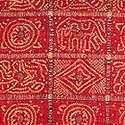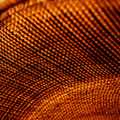The gharchola is the traditional Hindu and Jain wedding sari. The numbers of squares in it is ritually important – the number of squares are multiples of nine, 12, or 52. It used to be made of cotton but now silk is predominantly used.
The gharchola is essentially a bandhani sari. The technique of tie-dyeing cloth so that many small resist dyed spots produce elaborate patterns over the fabric is known as bandhini (bandhej) in the western Indian state of Gujarat.
History and Tradition
The bandhani technique is ‘believed to have existed in India since at least the late fifth century AD… but many of today’s western Indian [craftspeople] trace their ancestry back only two or three hundred years, to Pakistan’s Sind and Punjab.
Bandhanis are of various kinds:
|
According to Lynton: The ‘ghar’ is gharchola can be directly translated as ‘house’; however, it also connotes ‘birthplace’ and/or ‘family’, suggesting perhaps that the sari is from the home or birthplace of the brde (Lynton: p. 191).
Colours, Techniques and Motifs
The gharchola is a ‘single-colour saris…with white spots’. It is often red, though it can also be green. The network of squares is created by rows of white tie-dyed spots or rows of zari. Single motifs are created within each square – parrots, elephants, dancing girls, flowers – symbols of fertility, prosperity and joy. Sometimes zari is woven in, in discontinuous supplementary-weft patterning.
The making of the gharchola is a complicated and time-consuming process. A starched silk odhini or sari is fixed to a large wooden frame using nails. The sari/odhini, coloured red or green, is divided into a network of squares by rows of white tie-dyed spots or woven bands of zari. Motifs are then created within each compartment.



